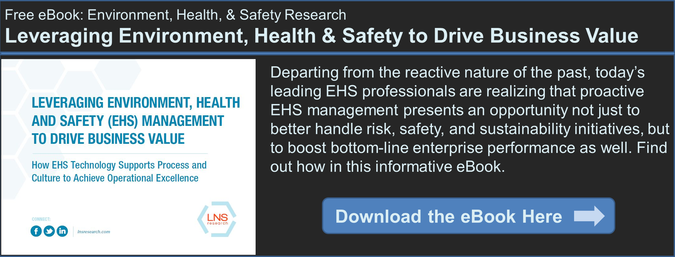 For better or worse, the landscape of regulations influences much of what goes on in manufacturing and industrial environments. Whether regulations are created to ensure product or process safety, drive improvements in environmental performance, or reduce the risk of adverse events, one consistency tends to be that they’re becoming increasingly complex and demanding.
For better or worse, the landscape of regulations influences much of what goes on in manufacturing and industrial environments. Whether regulations are created to ensure product or process safety, drive improvements in environmental performance, or reduce the risk of adverse events, one consistency tends to be that they’re becoming increasingly complex and demanding.
The fact of the matter is, if not given the right amount of attention and resources, regulations can impact manufacturers’ ability to meet Operational Excellence goals. Consequently, today’s leading companies are not only making investments to continuously satisfy regulatory requirements, many are doing everything possible to stay a step ahead of them.
With the flip of the calendar, it’s important to have a solid understanding of the current and prospective regulatory landscape. Our team put together a list of four actions you should know about in 2015.
1. Electronic Medical Device Reporting (eMDR) Rule
Back in February 2014, the FDA finalized its new eMDR rule for manufacturers and importers, which requires the use of a standardized format for reporting any abnormal events through the FDA’s online portal. It goes into effect August 14, 2015. While this new rule will likely benefit the safety of medical device products over time, it does pose a number of challenges for many companies in the short term.
Particularly, there are still a large number of medical device companies relying on outdated methods for document management and adverse event tracking. This issue becomes compounded when a larger company with multiple facilities—regionally or globally—has no standard method for document management or adverse event tracking. As a result to this upcoming rule, many companies in the industry have been quick to adopt next-generation solutions.
For medical device companies lagging behind on the transition, it’s important to evaluate vendors—likely either Enterprise Quality Management Software (EQMS) vendors or dedicated document management and adverse event tracking software vendors—with solutions that are built to hook into the gateway. Specialized vendors have modules specifically for electronic submissions to the FDA.
2. The Clean Power Plan
It’s no surprise that climate change is something people are taking more seriously. Back in September 2013, the EPA proposed a plan to cut carbon pollution from power plants. Revealed in June 2014, the plan would effectively provide states the ability to set their own emissions goals based on energy portfolios and resources. And then states would be required to submit a plan to meet those targets.
There are, however, opponents to the plan. For instance, John Pippy, CEO of the Pennsylvania Coal Alliance, said, "It will have dire consequences on state, regional and national economies if enacted. This is not just environmental regulation, it is a forced state energy policy." The decision on whether or not to enact the plan has been delayed, reportedly until mid-2015.
If (and when) it’s enacted, the limitations Congress might place on the EPA from an enforcement perspective will clearly impact manufacturers. Those pursuing improved sustainability footprints in response to consumer pressure may find it harder to achieve carbon targets if there are significant delays or if Congress weakens the EPA's ability to reduce carbon emissions. While energy costs may decline, the carbon content of that energy might not be supportive of a company’s sustainability objectives. Watching what happens on this initiative is essential if energy is a substantial part of your operating expenses.
3. OSHA Requirements
Though they took effect earlier this month, on January 1, 2015, OSHA has new recordkeeping rule requirements that affect almost every employer across the U.S. and will be increasingly enforced throughout the year. According to the new changes, employers must report all work-related fatalities within eight hours of occurrence. Further, any work-related in-patient hospitalizations, amputations or losses of eyes must be reported within 24 hours. These are small, yet sweeping changes that could result in serious consequences if not adhered to.
It hasn’t been finalized yet, but we can look forward to an anticipated final rule on slips, trips and falls in June of this year. The rule should establish new personal fall protection system standards in order to minimize one of the leading causes of workplace injury across the U.S. every year. It’s about time, too, as the rulemaking process has been underway since 1990.
Additionally, many manufacturers will be aware of incoming requirements related to the OSHA Hazard Communication Standard (HCS) which calls upon pretty much all businesses to align to the Globally Harmonized System of Classification and Labeling of Chemicals (GHS). Coming into effect on June 15, businesses will be required to meet an array of new labeling and classification requirements for chemical products.
4. The Food Safety Modernization Act (FSMA)
In 2014, we heard a lot about how the proposed FMSA rules would result in major changes for manufacturers. And during that year, it was announced that the FDA would be sticking to the court ordered deadlines of implementing the new requirements between the fall of 2015 and the spring of 2016. With all signs indicating a green light, manufacturers should be preparing accordingly.
The goal behind the FSMA is to ensure the U.S. food supply is safe, shifting focus away from responding to contamination toward preventing it in the first place. One of the most significant changes for manufacturers will be around data management, archiving, and retrieval as materials move upstream to downstream. Rules will also be around supplier verification and management as well as controlling supply chain risk.
Again, technology will be key. The most effective companies will have a robust supplier quality management strategy in place, complete with risk-based controls. Companies should also evaluate the integration between EQMS and Manufacturing Operations Management (MOM) solutions. This will be critical for ensuring timely and efficient production, while satisfying all compliance requirements and having records for validation.
Something to Keep in Mind as You Move Through 2015
As we’ve discussed at LNS Research in the past, there are many companies that work to meet compliance just for the sake of it. And then there are some companies that go beyond compliance requirements with intentions of creating real business value. Many of these regulations can be looked at through that lens.
For instance, in many ways it makes business sense to have a robust supplier quality management system to prevent and control contamination beyond compliance requirements. One such benefit may be the ability to predict and contain contamination, and consequently conduct more targeted recalls if needed. This directly relates to reputation and profitability.
Similar reasoning can be made for producing goods more efficiently or ensuring employee safety. As you formulate your 2015 strategy and react to the current and impending changes, think about the bigger picture of driving better business performance than doing the bare minimum.

________________________________________

About the author:
Mike Roberts is a researcher and marketer at LNS Research. He covers the manufacturing and industrial spaces, with a focus on emerging technologies like the Internet of Things, Big Data, and Mobility. Check out more of his articles here, follow him on Twitter and connect with him on LinkedIn.